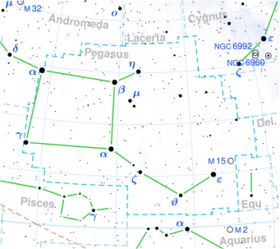Astronomy:Rho Pegasi
| Observation data Equinox J2000.0]] (ICRS) | |
|---|---|
| Constellation | Pegasus |
| Right ascension | 22h 55m 13.66706s[1] |
| Declination | 8° 48′ 58.2387″[1] |
| Apparent magnitude (V) | 4.90[2] |
| Characteristics | |
| Spectral type | A1V[3] |
| U−B color index | +0.00[2] |
| B−V color index | +0.00[2] |
| Astrometry | |
| Radial velocity (Rv) | −10.6±0.9[4] km/s |
| Proper motion (μ) | RA: +80.370[1] mas/yr Dec.: +13.282[1] mas/yr |
| Parallax (π) | 11.9131 ± 0.2232[1] mas |
| Distance | 274 ± 5 ly (84 ± 2 pc) |
| Absolute magnitude (MV) | +0.01[5] |
| Details | |
| Mass | 2.84[6] M☉ |
| Radius | 3.1[7] R☉ |
| Luminosity | 110[6] L☉ |
| Surface gravity (log g) | 3.90[8] cgs |
| Temperature | 9,484[6] K |
| Rotational velocity (v sin i) | 107[6] km/s |
| Age | 331[8] Myr |
| Other designations | |
| Database references | |
| SIMBAD | data |
Rho Pegasi, Latinized from ρ Pegasi, is a star in the northern constellation of Pegasus, near the southern constellation boundary with Pisces. This is a probable astrometric binary system, as determined by changes to the proper motion of the visible component.[10] It has a white hue and is faintly visible to the naked eye with an apparent visual magnitude of 4.90.[2] The system is located at a distance of approximately 274 light years from the Sun based on parallax,[1] but it is drifting closer with a radial velocity of −10.6 km/s.[4]
This visible component is an A-type main-sequence star with a stellar classification of A1V.[3] The star is 331[8] million years old and is spinning with a projected rotational velocity of 107 km/s.[6] It has 2.8[6] times the mass of the Sun and 3.1[7] times the Sun's radius. The star is radiating 110[6] times the luminosity of the Sun from its photosphere at an effective temperature of 9,484 K.[6]
References
- ↑ 1.0 1.1 1.2 1.3 1.4 1.5 Brown, A. G. A. (August 2018). "Gaia Data Release 2: Summary of the contents and survey properties". Astronomy & Astrophysics 616: A1. doi:10.1051/0004-6361/201833051. Bibcode: 2018A&A...616A...1G. Gaia DR2 record for this source at VizieR.
- ↑ 2.0 2.1 2.2 2.3 Ducati, J. R. (2002). "VizieR Online Data Catalog: Catalogue of Stellar Photometry in Johnson's 11-color system". CDS/ADC Collection of Electronic Catalogues 2237. Bibcode: 2002yCat.2237....0D.
- ↑ 3.0 3.1 Cowley, A. et al. (April 1969), "A study of the bright A stars. I. A catalogue of spectral classifications", Astronomical Journal 74: 375–406, doi:10.1086/110819, Bibcode: 1969AJ.....74..375C
- ↑ 4.0 4.1 Gontcharov, G. A. (2006). "Pulkovo Compilation of Radial Velocities for 35 495 Hipparcos stars in a common system". Astronomy Letters 32 (11): 759–771. doi:10.1134/S1063773706110065. Bibcode: 2006AstL...32..759G.
- ↑ Anderson, E.; Francis, Ch. (2012). "XHIP: An extended hipparcos compilation". Astronomy Letters 38 (5): 331. doi:10.1134/S1063773712050015. Bibcode: 2012AstL...38..331A. Vizier catalog entry
- ↑ 6.0 6.1 6.2 6.3 6.4 6.5 6.6 6.7 Zorec, J.; Royer, F. (2012). "Rotational velocities of A-type stars". Astronomy & Astrophysics 537: A120. doi:10.1051/0004-6361/201117691. Bibcode: 2012A&A...537A.120Z. Vizier catalog entry
- ↑ 7.0 7.1 Allende Prieto, C.; Lambert, D. L. (1999). "Fundamental parameters of nearby stars from the comparison with evolutionary calculations: Masses, radii and effective temperatures". Astronomy and Astrophysics 352: 555–562. Bibcode: 1999A&A...352..555A. Vizier catalog entry
- ↑ 8.0 8.1 8.2 David, Trevor J.; Hillenbrand, Lynne A. (2015). "The Ages of Early-Type Stars: Strömgren Photometric Methods Calibrated, Validated, Tested, and Applied to Hosts and Prospective Hosts of Directly Imaged Exoplanets". The Astrophysical Journal 804 (2): 146. doi:10.1088/0004-637X/804/2/146. Bibcode: 2015ApJ...804..146D. Vizier catalog entry
- ↑ "rho Peg". SIMBAD. Centre de données astronomiques de Strasbourg. http://simbad.u-strasbg.fr/simbad/sim-basic?Ident=rho+Peg.
- ↑ Eggleton, P. P.; Tokovinin, A. A. (September 2008), "A catalogue of multiplicity among bright stellar systems", Monthly Notices of the Royal Astronomical Society 389 (2): 869–879, doi:10.1111/j.1365-2966.2008.13596.x, Bibcode: 2008MNRAS.389..869E.
 |


